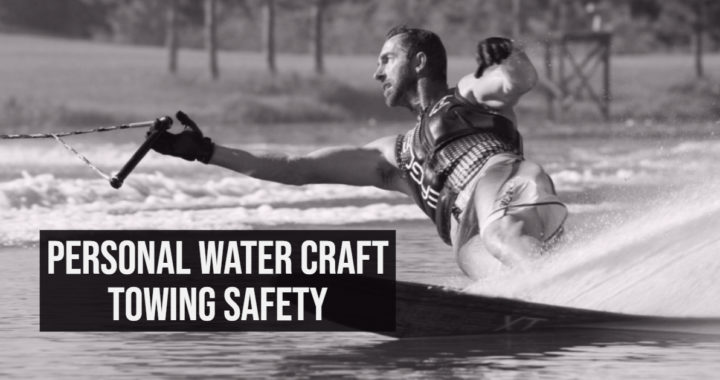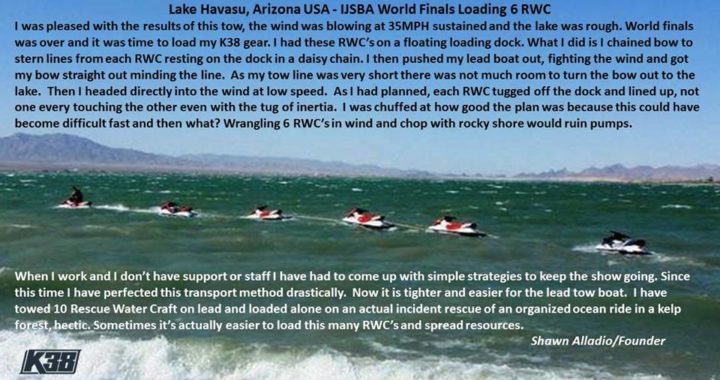KNOW BEFORE YOU TOW
Personal Water Craft used for the purpose of towing and aquaplane device are to be of the three-seater capacity.
Three-seater Personal Water Craft designed for towing will have rear-view mirrors. Single and Tandem use Personal Water Craft are not permitted or designed to tow an aquaplane device with.
Some of the equipment types defined as a towable aquaplane device (TAD)
1. Foils
2. Inner tubes/floats
3. Wakeboard
4. Water Skiers
Do not drive or reverse back over the tow line. It will foul the driveline and cause damage to the water jet pump and the vessel will have to be placed under tow not faster than 8 miles per hour to prevent engine damage for some models.
All occupants on board must be wearing a USCG approved properly fitted and sized lifejacket.
Towing can only be done with 3 persons for a 3-seater Personal Water Craft and not exceed the manufacturer recommended weight load. For instance, as example a Kawasaki Ultra LX Jet Ski is 496 lbs. or up to three persons on board.
Towing can be accomplished with 4 persons with the older two stroke 4-seater watercraft which are no longer manufactured (date of this publication 6.23.2019).
In some states the Observer or Flagger is to sit reverse on the rear seat to maintain observation of the safety of the towing person and equipment. They are to keep a lookout. They are to have a required safety flag ready to display in case of traffic, an emergency or recovering the towable aquaplane device and person in the water.
Be mindful of the tow rope snapback and wrapping hands and fingers, which can lead to serious injury.
Wear protective equipment and a wetsuit to protect vaginal, orifice or rectal tears and impact from the water jet thrust. Pay attention to all the manufacturer’s warning labels of the towing equipment and the Personal Water Craft.
A few more suggestions for safety underway:
• Take a safe boating course
• File a float plan
• Learn how to right a capsized Personal Water Craft
• Keep intake clearing tools on board
• Bring a waterproof GPS and communication device
• Monitor weather on the NOAA weather channel
Make sure the people you bring on-board your Personal Water Craft are briefed on safety and the boating rules and regulations in your area. Practice in a safe area, observe for boating traffic and practice good communication skills with your team.
Inspect your equipment for damage. Inspect your rope and attachment points. Clean, wash and stow when completed.
PWC SAFETY
Does your state allow Personal Water Craft to pull water skiers?
If answered "Yes" to the previous question, are there any restrictions?
Alabama Yes Must have 2 mirrors, with a minimum viewing area of 10 square inches each, measuring a minimum of 2.5 inches tall and 4.0 inches wide. These mirrors must be mounted, one on each side, on the body (not the steering mechanism) of the PWC in such a way as to maximize the rear viewing of the operator.
Alaska Yes
American Samoa No
Arizona Yes Watercraft cannot be overloaded. All requirements apply.
Arkansas Yes Must have onboard an observer at least 12yrs or older and the PWC must be able to ride 3 or more persons. Mirrors are not allowed in lieu of an observer.
California Yes There is no exemption from having an observer with a ski flag that must be available for use on board the vessel.
Colorado yes An observer must be onboard the PWC and a skier down flag must be used.
Connecticut Yes 3 and 4 person PWC's only - must have a backward facing observer
Delaware Yes yes
District of Columbia Yes Must have a mirror and an observer facing the skier
Florida Yes PWCs must have a person, in addition to the operator, in a position to observe the progress of the skier or have a wide-angle rearview mirror mounted in such a way as to permit the operator to see the progress of the skier.
Georgia Yes Must be a three-seater with one observer.
Guam Yes Same as any water ski operations
Hawaii Yes same as any vessel towing water skiers
Idaho Yes Cannot exceed capacity, skiers must wear PFDs, and must have an observer and flag.
Illinois Yes PWC must have seat for skier (no overloading) and PWC must have lifejacket onboard for skier if not wearing it...
Indiana Yes PWC must be at least 9 feet in length and designed for 3 occupants. Must also have observer on board when towing a skier or tuber.
Iowa Yes Must be a three passenger PWC.
Kansas Yes Must have an observer or mirrors to obtain a maximum view behind and hoist skier down flag
Kentucky Yes A wide-angle mirror or observer
Louisiana Yes must have a mirror or an observer
Maine Yes In addition to the operator, must have a person onboard at least 12 years of age, who is in a position to continually observe the person being towed.
Maryland Yes PWC's must be able to carry operator, observer and skier (at least 3pob capacity)
Massachusetts No
Michigan Yes Must have an observer and everyone wearing a PFD.
Minnesota Yes Must have observer or factory installed or factory authorized rear view mirrors.
Mississippi Yes Must have observer
Missouri Yes Must have an observer aboard.
Montana Yes must have an observer
Nebraska Yes skier counts as part of the capacity of the vessel/PWC
Nevada Yes Vessel must be rated to hold 3 people
New Hampshire Yes Must have an operator and observer on board.
New Jersey Yes follow all ski laws, including ski flag, observer must face aft to tend to skier. PWC must hold at least 3 people
New Mexico Yes Mandatory PFD wear, observer on board, seat for skier.
New York Yes must be a three person or greater machine
North Carolina Yes No person shall operate a personal watercraft towing another person on water skis, a surfboard, or similar device unless: (1) The personal watercraft has on board, in addition to the operator, an observer who shall monitor the progress of the person or persons being towed, or the personal watercraft is equipped with a rearview mirror; and (2) The total number of persons operating, observing, and being towed does not exceed the number of passengers identified by the manufacturer as the maximum safe load for the vessel.
North Dakota Yes Must have an observer on board and must not operate between one hour after sunset to one hour before sunrise.
Northern Mariana Islands No none
Ohio Yes Must have an observer at least 10 yrs. old on board.
Oklahoma Yes Must be designed to accommodate two or more persons and must have proper observer 8 YOA or older or two convex rear-view mirrors so placed so the operator can face the direction traveled and observe the progress of the person being towed.
Oregon Yes PWC must be able to carry operator, observer, and skier
Pennsylvania Yes one skier only must have an observer
Puerto Rico No
Rhode Island Yes observer over age of 12 required- must be designed for and capable of carrying the skier and observer and operator
South Carolina Yes PWC must have wide angled rearview mirrors or an observer. PWC must be rated for 3 people if and observer is on board.
South Dakota Yes
Tennessee Yes Observer and/or mirrors
Texas Yes Must not exceed passenger capacity
Utah Yes same law as traditional boats
Vermont Yes Must have an observer.
Virginia Yes Capacity of the PWC must be able to legally accommodate the operator, passengers, and those being towed.
Washington Yes None.
West Virginia Yes Must have an observer or mirror
Wisconsin Yes PWC's designed for 3.
Wyoming Yes No. Same as boats
When referencing the rules above, please check in with your State Boating Law Administration to see if any changes or updates have been made.
______________________
Posted: June 23, 2019
Content Creator of Rescue Water Craft and Personal Water Craft boating international education standards: Shawn Alladio is the world’s foremost authority and leading subject matter expert. She cares most about her community and the culture surrounding the safety of event service providers and Rescue Water Craft operators, working hard and dedicated towards protecting their reputation, distributing safety information and continuing to train these amazing individuals to the highest standards of care.
__________
Have any questions? Join the Rescue Water Craft Association
and discover what your community is doing to modernize standards, safety and reduce liability!
Join the Rescue Water Craft Association
Use at your own risk. Please take a qualified Rescue Water Craft training course and maintain proper records and respect all the PWC, RWC, PPE, and gear OEM manufacturer warning labels and cautions.

